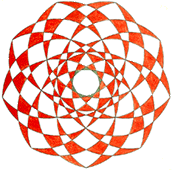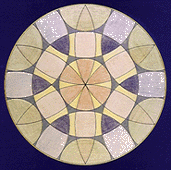|
Praxis für Alternative
Psychosomatik und Traumdeutung, Dr. Remo F. Roth, CH-8000
Zürich
|

|
Remo F. Roth
Dr. oec. publ., Ph.D.
dipl. analyt. Psychologe (M.-L. v.
Franz)
|

|
© 200 2-2004
by Pro Litteris, Zurich, Switzerland and Remo F. Roth, Horgen-Zurich. All Rights
Reserved. dr.remo.roth@psychovision.ch.
Republication and redissemination of the contents of this screen or any part of
this website are expressly prohibited without prior psychovision.ch written
consent.
With many thanks to Gregory Sova, Ph.D.
(LA, CA) for
translation assistance
Book Project:
THE RETURN OF THE WORLD SOUL
Wolfgang Pauli, Carl Jung and the Challenge
of the Unified Psychophysical Reality
© copyright 2002-2004 by
Pro Litteris, Zürich. All rights reserved
This book is
intended for private use only, and is copyrighted under existing Internet
copyright laws and regulations.
back
to Chapter 2
/ back
to Contents
3. Carl Jung's
quaternity, Neoplatonic philosophy and the "potential being" of
Aristotle
(part
1)
Contents:
part1:
3.1
Wolfgang Pauli's criticism at the newly founded
institute
3.2 Carl Jung's "quaternities, projected
into heaven"
part
2:
3.3
Being, nonbeing and potential being
3.3.1
The Assumptio Mariae and the "disinfected" matter in the
heaven
3.3.2 The
coniunctio as the constellated archetype behind the
Assumption
3.3.3 The
coniunctio and Carl Jung's individuation
process
3.3.4 "To
be or not to be" and the Platonic privatio
boni
part
3
(will follow):
3.3.5
The potential being of Aristotle
3.3.6
Complementarity: Particle and wave as potential
being
3.3.7
Pauli's conflict with Jung: The collective unconscious as
potential being
part
4:
3.3.8 "Quaternities projected into heaven" and
the unsolved psychophysical problem
3.3.9 The
spirit of matter, the acausal aspect of the divine world soul
and potential being
3. Carl Jung's quaternity,
Neoplatonic philosophy and the "potential being" of
Aristotle
(part 1)
3.1 Wolfgang Pauli's
criticism at the newly founded institute
A little more than two years after the
foundation of the C.G. Jung Institute in Zurich, Wolfgang Pauli was
very disappointed about its development. In a letter of 1950 to his
colleague Abraham Pais he writes:
"Denn es lässt sich
nicht leugnen, dass in Jungs speziellem Kreis eine
ausserordentlich starke geistige Inzucht herrscht (infolge eines
vollkommenen Mangels an schöpferischer Geister und
Talente in diesem Kreis) ..."
English translation:
"But it is undeniable,
that in Jung's specific circle an extraordinary strong mental
incest exists (as a result of a complete lack of creative minds and
talents in this circle) ..."
Two and a half years later he was forced to
proclaim that the quality of research was not up to his expectations.
In a caustic letter of March 16th, 1953 to C.A. Meier, his friend and
first president of the C.G. Jung Institute in Zurich, he writes:
"Die provinzielle
Atmosphäre des C.G. Jung-Instituts (in welchem sich jeder
für ein verkanntes Genie zu halten scheint, weshalb auch
jeder jeden anderen im Grund nicht ausstehen kann) ist einem
solchen kritischen Abwägen [der wissenschaftlichen
Leistungen; RFR] allerdings gar nicht förderlich, da sie
für ein solches keinen genügenden objektiven Massstab
zur Verfügung hat."
English translation:
"The provincial atmosphere
of the C.G. Jung Institute (in which everyone seems to hold
him/herself up as an unrecognised genius, causing everyone to
dislike each other) does not at all further such a critical
judgement [of scientific efforts; RFR], because for this
[task], it [the atmosphere] does not have an
objective measure at its disposal." [translation
mine]
Later, Pauli - in his capacity as scientific
patron of the institute - formulates his criticism in an official
letter to the Curatorium, the management of the institute, and to
C.A. Meier, its first president. Meier published this letter of the
year 1956 and a further one of 1957 in Atom and Archetype. In
the first Pauli writes:
"In recent years, I have
noted with grave concern that the scientific approach is
becoming increasingly neglected in matters relating to the
C.G. Jung Institute and the activities of its members. As the
scientific patron of the Institute, I thus regard it as my duty
to draw attention to the standpoint of the sciences, and I
must therefore officially request certain information from you as
President."
Then he continues:
"It is clear to me that in
addition to the scientific aspect of psychology, there is also a
humanistic one, but I do not see it as my duty to defend
that. In this connection, I should like to point out that
psychology always used to be counted as one of the
humanistic sciences, but it was precisely C.G. Jung himself
who emphasized the scientific nature of his ideas, and it was
through his works that the way was paved for an integration of the
psychology of the unconscious into the natural sciences. It is my
opinion that the progress that has been made in this respect is
being seriously jeopardized by the administration of the C.G. Jung
Institute."
Then he goes on and criticizes
further
"the general intellectual
level of the psychotherapeutic practice. This is where there is
the greatest danger that the practice might degenerate into a
completely unscientific conveyor-belt system [Massenbetrieb in
German; RFR], dominated by the formal-arithmetic principle (with
pecuniary factors involved), using the time available to deal with or 'get
through' as large a number of
patients as possible with as little thought input as possible."
When we look at the C.G. Jung Institute of
today, we see that nothing has changed in the past 50 years since
Pauli's criticism of the lack of scientific research being conducted
by the Jungian community. Therefore we must ask ourselves, "What are
the deeper reasons that could be responsible for these grievances?"
We will disregard Pauli's criticism about the "conveyor-belt system"
[Massenbetrieb] with its "pecuniary factors involved".
Because it is the general human condition involved in these
deficiencies, it seems that even Jungian depth psychology with its
high ethical claims for being able to live more consciously cannot
cause such deficiencies to be properly addressed.
3.2
Carl Jung's "quaternities, projected into heaven"
Even before the composition of these letters
to C.A. Meier and the Curatorium of the C.G. Jung Institute, Pauli is
not sparing of direct criticism of Carl Jung. In May, 27th 1953 he
writes him in connection with a dream about Einstein (s. below),
which talks of a deeper reality behind quantum physics that Pauli
combines with the sought after synthesis of physics and depth
psychology:
"Denn es lässt sich
nicht leugnen, dass diese [analytische Psychologie; RFR]
wie ein illegitimes Kind des Geistes ausserhalb der allgemein
anerkannten akademischen Welt ein esoterisches Sonderdasein
führt."
English translation:
"For there is no denying
the fact that [analytical; RFR] psychology, like an
illegitimate child of the spirit, leads an esoteric, special
existence beyond the fringe of what is generally acknowledged to
be the academic world."
Shortly before, in February 1953, he
addresses another reproach to Jung:
"Solange man
Quaternitäten fern von Menschen 'im Himmel
aufhängt' … , werden keine Fische gefangen, der
Hierosgamos unterbleibt und das psychophysische
Problem bleibt ungelöst." [emphasis mine]
English translation:
"As long as
quaternities are 'projected into heaven' at a great distance
from people... no fish will be caught, the hierosgamos is
absent, and the psychophysical problem remains
unsolved." [translation and emphasis mine]
For the reader this sentence may be too
cryptic. Therefore we must ask ourselves what a "quaternity projected
into heaven" could have to do with the hierosgamos, the sexual
unity of a female and a male god, and with the sought after solution
of the psychophysical problem.
To do this, we will examine three letters of
Pauli's of the year 1953, in which he developed his ideas about the
relation of Jung's quaternity with the problem of the unified
psychophysical reality - the so-called unus mundus or united
world. The first is the above quoted letter of February 1953 to Jung,
the second to Markus Fierz of October 1953 and the third to
Marie-Louise von Franz of November 1953 (see section 5.1).
Carl Jung was fascinated by the archetype of
the quaternity. We can see this for example in his typology of the
consciousness. He distinguishes four different functions: thinking
and its opposite, feeling, as the so-called rational functions, and
sensation with its opposite, intuition, as the so-called irrational
functions. The important aspect in Jung's typology is the fact, that
three of these four functions can be more or less conscious, but the
fourth is "the totally different" ("das ganz Andere"). It represents
the bridge to the unconscious and cannot be developed. Therefore the
fourth function remains accessible only in an archaic or primitive
manner. Like this the fourth disturbs consciousness in an unconscious
way, which means, for example, that it comes up into one's
consciousness through a slip of the tongue or by forgetting the name
of the person you are talking too - the Freudian slip.
The unintegrated fourth manifests in certain
specific ways depending on one's particular psychological typology. A
thinking type, for example, can develop his sensation and intuition,
but never his feeling. Therefore this fourth function comes up in a
negative way, a behaviour one can observe very well in scientific
discussions. An intuitive type has incredible troubles with the
sensation, with his five senses, therefore also with his body.
Sensation types develop incredible negative intuitions about their
surrounding, and so on.
In Carl Jung's model, the collective
unconscious is also structured in a fourfold way; therefore he
preferred symmetries of this kind. Threefold and especially fivefold
symmetries he looked at as an expression of a "distortion". He
writes:
"'Distorted' mandalas
occur from time to time. They consist of all forms that deviate
from the circle, square, or regular cross, and also of those based
not on the number four but on three or five. The numbers six and
twelve are something of an exception. Twelve can be based on
either four or three. The twelve months and the twelve signs of
the zodiac are definite symbolic circles in daily use. We are also
acquainted with a symbolic circle based on six. [German
original: 'Ebenso ist die Sechs ein bekanntes Kreissymbol.'
RFR] Three suggests the predominance of idea and will
(trinity), and five that of the physical man (materialism)."
[CW 12, § 287]
In his UFO essay Jung reduces the six-fold or
double-triadic mandala, the Seal of Solomon, in a very unusual way to
a quaternity [GW 10, § 771]. In our context Jung's
interpretation is extremely important because the dreams of
Wolfgang Pauli are full of this double-triadic symbol. We
will see that this is the deeper reason why the Nobel laureate was
occupied so intensely with Robert Fludd's opus in which the
double-triadic structure plays a very important role.
The trouble with Jung's preference for the
quaternity as a symbol of the Self is the fact that we never know if
it is some sort of a (3+1) structure, as in the concept of his
typology, or if he speaks of a fourfold symmetry, in which all
members having equal rights. As we have seen, in his typology the
(3+1) structure serves the distinction between the "trinity" of the
conscious functions and its opposite, the monistic unconscious one.
But in his model of the unconscious' center, the so-called Self, he
prefers the quaternity in the shape of a square, which means that all
members are equally weighted. Thus, we can already conclude here that
this ambivalence shows a certain unconsciousness of Jung in relation
to the problem of the fourth.
Chapter
3, part 2
See also further articles about
Wolfgang Pauli in
http://www.psychovision.ch/rfr/roth_e.htm
back

13.2.2003
|